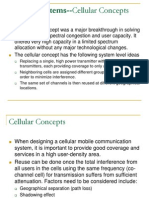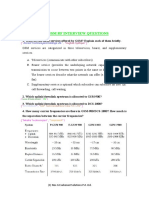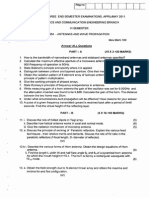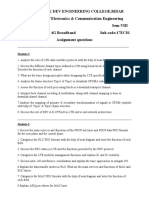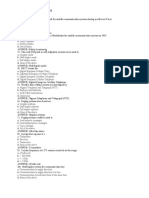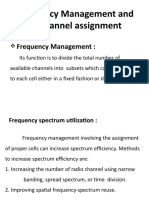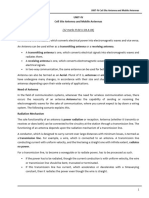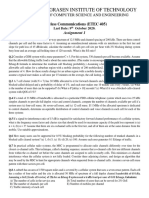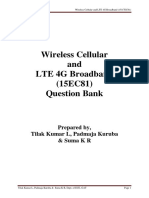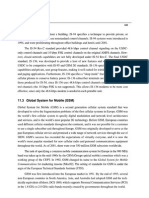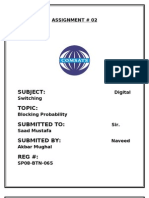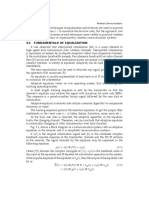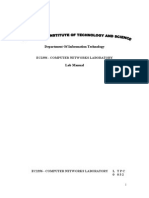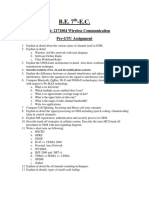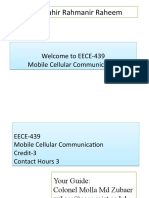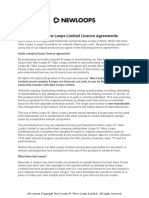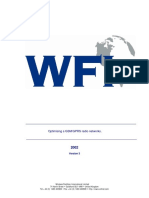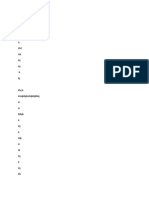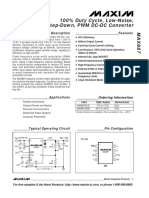University of Asia Pacific
Department of Electrical and Electronic Engineering
Repeat Examination Spring – 2015
Program: B. Sc. Engineering (4rd Year/ 2nd Semester)
Course Title: Mobile Cellular Communication Course No: EEE 439 Credit: 3.00
Time: 3.00 Hours. Full Mark: 150
There are Eight Questions. Answer any Six. Figure in the right margin indicate marks.
1.(a) Derive the equation, N = i2 + ij + j2 for 9-cell cluster system. What is frequency reuse 10
factor?
(b) Briefly describe fixed channel assignment, dynamic channel assignment and hybrid channel 10
assignment systems.
(c) How cells are created in a GSM coverage area? Why theoretical cell structure are different 05
from practical cell structure?
2.(a) Describe the importance of handoff margin in defining the handoff condition of a cellular 05
sytem.
(b) What is ping-pong effect? How this effect can be removed? Show the necessary figures. 05
(c) Describe the different types of handover in GSM cell structure. Write about hard handoff, 15
soft handoff and softer handoff.
3.(a) For a cluster system of N = 9, minimum co-channel interference ratio is required 15 dB. 08
Find out the CIR and worst-case CIR.
(b) How does capacity improvement occur with cell sectoring and cell splitting? 10
(c) Explain the importance of umbrella cell and selective cell. 07
4.(a) Show the derivation of the mathematical model of Two-Ray model. 20
(b) Suppose at a distance of 100 meter, received power is -24.5 dBm. Find the distance where 05
the received power will be -64.5 dBm.
5.(a) Compute the loss due to knife-edge diffraction when transmitter height is 50 m, receiver 10
height is 25 m, obstacle height is 100 m, distance between transmitter and obstacle is 10 km
and distance between obstacle and receiver is 2 km. Assume operating frequency is 900
MHz. Also find the obstacle height to induce 6 dB diffraction loss.
(b) Derive the mathematical model for knife-edge diffraction model. 10
(c) Derive the equation of Doppler shift. 05
6. Assume for an open rural area f = 1500 MHz, ht = 200m, hr = 3m and Gt = Gr = 0 dB. If the 25
received power at a reference distance 1 km is equal to 1 microwatt, find the received
powers at distance of 10 km and 20 km from the same transmitter using
i. Free space propagation model
ii. Two-ray reflection model
iii. Okumura model
iv. Hata model
Page 1 of 4
�7.(a) Describe π/4 QPSK modulation technique. Show how this modulation technique is better 10
than other QPSK techniques.
(b) What are the influencing factors for the choice of digital modulation? Why these are 7
important? What is the data rate in a 200kHz channel for SNR = 30 dB.
(c) Write a short note on TDMA time frame. If a GSM time slot consists of six trailing bits, 8 8
guard bits, 26 training bits, and two traffic bursts of 58 bits of data, find the frame
efficiency. Assume a GSM frame has 8 time slots.
8.(a) Describe briefly the following nodes of a GSM architecture. 10
i. VLR
ii. BTS
iii. BSC
iv. AUC
v. MSC
(b) Write down the functions of a mobile when it is active in a GSM network. How location of 10
a mobile is updated when it moves from one location to another? Show the illustration with
corresponding nodes of GSM system.
(c) How does a SMS send from one mobile to another mobile? Describe the process with every 5
node related to the SMS.
Page 2 of 4
�Necessary Equations:
( )=
(4 )
2 2 ℎℎ
( )=
ℎ ℎ
=
2( + ) 2
= =
( + )
( ) = 0, ≤ −1
( ) = 20 log(0.5 − 0.62 ) , − 1 ≤ ≤0
( ) = 20 log(0.5exp (−0.95 )) , 0 ≤ ≤1
( ) = 20 log 0.4 − 0.1184 − (0.38 − 0.1 ) , 1 ≤ ≤ 2.4
0.225
( ) = 20 log , > 2.4
( )= + ( , ) − (ℎ ) − (ℎ ) −
ℎ
(ℎ ) = 20log ( )
200
ℎ
(ℎ ) = 10log ( )
3
ℎ
(ℎ ) = 20log ( )
3
( )( ) = 69.55 + 26.16 − 13.82 ℎ − (ℎ ) + (44.9 − 6.55 ℎ )
( )= ( ) − 2 log − 5.4
28
( )= ( ) − 4.78 log( ) + 18.33 log( ) − 40.94
(ℎ ) = (1.1 − 0.7)ℎ − (1.56 − 0.8)
(ℎ ) = 8.29( 1.54ℎ ) − 1.1
(ℎ ) = 3.2( 11.75ℎ ) − 4.97
Page 3 of 4
�Page 4 of 4





